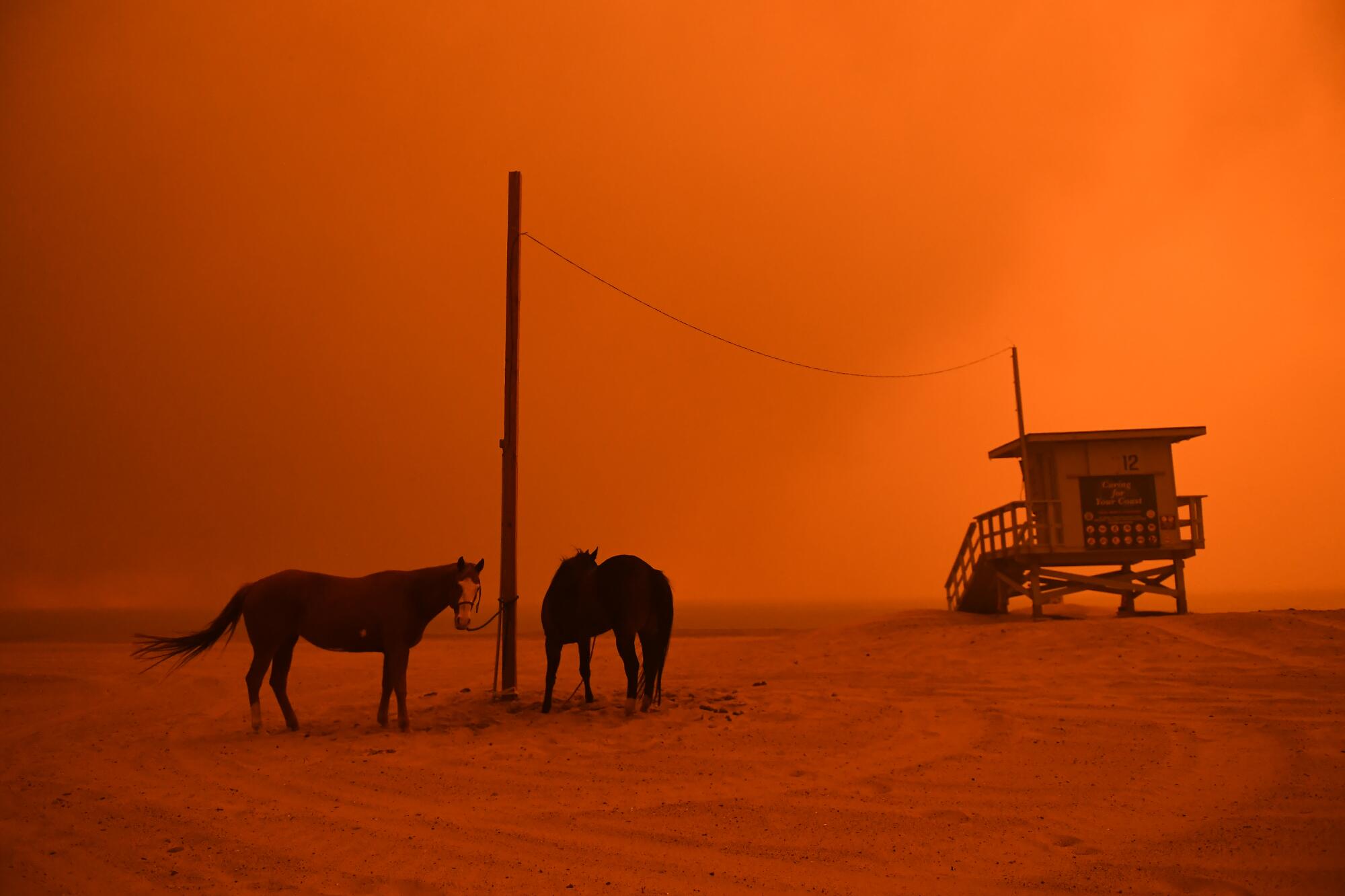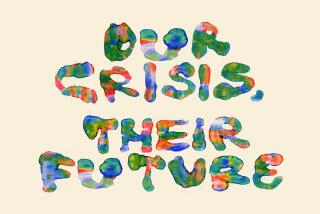
On the Shelf
'Climate Fiction' is Not a Genre
Appleseed
By Matt Bell
Custom House: 480 pages, $28
Believers: Making a Life at the End of the World
By Lisa Wells
FSG: 352 pages, $28
If you buy books linked on our site, The Times may earn a commission from Bookshop.org, whose fees support independent bookstores.
When I was 12, I had a fascination with Harlequin romances. They could be had for a dime at an odd store full of used bric-a-brac that I could walk to from my house.
I consumed the slim paperbacks like candy and kept them on a dedicated shelf near my bed. I admitted to my parents they were silly and liked to mark up the typos with a self-righteous zeal, but I was also captivated by the arc they described. In every book, contempt and hostility between the heroine and hero morphed, at the last minute, into an outpouring of mutual desire resulting in a conjugal union. Beneath the veneer of seemingly total disregard a woman might encounter in a breathtakingly attractive man (the binaries were set), a secret adoration always hovered.
Noted. And yet, as I move through life and occasionally encounter such handsome men, I find myself immune to the Harlequins’ lessons: I do not typically suspect that behind these men’s disinterest lies a hidden love for me. Even as a kid, I saw that the Harlequins were a form of thought-magic. Much like the science fiction, fantasy and murder novels I read too.
Later I learned that scholars and critics often distinguish between “serious” and genre fiction: The former tends to be defined as culturally important, the other seen mostly as a light diversion. The merits of that distinction are debatable, but it exists nonetheless. Partly, we’re told, it’s the attention to language that separates the two, but it’s also the form and content. Genre fictions define themselves by the set of counterfactuals they embrace.
In romances like Harlequins, the counterfactual is that monogamous coupling is the ticket to enduring bliss. In fantasy, it’s that impossible transformations are actually possible, while in science fiction the building of alternate universes is based not on magic but a materialist analog — speculations about possible extensions of technology into human society. With detective stories, the conceit is that the deconstruction of a violent murder — the grislier the better — followed by the meting out of justice equates to a vindication of the social order.
“We wanted a lot of light in the space,” says Bea Koch from one of the baroque, Victorian couches that form a makeshift living room in the center of the Ripped Bodice, America’s sole romance-only bookstore, which she owns with her sister Leah.
Readers’ loyalty to their chosen hypotheticals defines their reading environment: Genre becomes both a brand and an affinity group. Its subcultures have become so established that when writing deemed to be literary calls upon the conceits of fantasy, science fiction, mystery or horror, it’s described as “genre-bending.” Writers can use genre conventions and still be considered literary if they do so from a state of narrative self-consciousness, knowingly collapsing the conventions into a realist framework.
The takeaway is that all popular fiction genres, whether or not they go by the name “fantasy,” are united by a commitment to it; some systems of make-believe are just encoded more subtly than others. In sci-fi and fantasy the pretend is a literal escape from the everyday. In romance and mystery, the escape is psychological; a cathartic moment occurs and readers find affirmation of dearly held longings.
Among the most recently anointed genres is one called climate fiction, or cli-fi, in theory a subset or relative of the speculative or dystopic. Under this heading a growing number of new books has been placed by publishers, reviewers or bookstores. In the last couple of years this has included novels ranging from the literary — Diane Cook’s “The New Wilderness,” Richard Flanagan’s “The Living Sea of Waking Dreams,” Jenny Offill’s “Weather” and my most recent novel, “A Children’s Bible” — to melodramatic, doomed romances like “Migrations” by Charlotte McConaghy; from rationalist sci-fi like “The Ministry for the Future” by Kim Stanley Robinson to Jeff VanderMeer’s quasi-noir “Hummingbird Salamander” and hybrids like Matt Bell’s “Appleseed.”
Of these, “Appleseed,” out next week, is the most multivariate in genre terms. Two of its three storylines are anchored in science fiction — like “The Ministry for the Future” they have plots that hinge partly on geoengineering projects meant to curb global warming — while the third narrative relies on a shape-shifting fantasy based in both the folk tale of Johnny Appleseed and in ancient Greek mythology.
In “Appleseed,” magic and science aren’t integrated but simply juxtaposed; the juxtaposition suggests that mythologies of hybrid human beasts have been transferred over time into imaginings of robot beasts, genetically modified creatures and people who can exist outside their bodies. It proposes a fungibility of matter and consciousness that’s both horrific and transcendent.
Jenny Offill’s lapidary masterwork, “Weather,” is about unstable climates and families.
Meanwhile, novels like “Weather” aren’t bound to genre, since they depend on no obvious counterfactuals but consist of characters, amid the vexations of their personal lives, bumping up against the ambient dread that seems to be descending, for many of us, from science’s grim projections of the future. It might be argued that this domestic-existential realism is itself a genre, but in that case, it’s the genre that most closely mirrors daily routines — since we don’t live in interstellar space, Regency England or countrysides presided over by multiple purple moons where dryads step out of oak trees half-naked to sing and brush their hair.
Aside from some shared source material, the highly diverse novels sometimes referred to as cli-fi have little in common beyond a recognition of the terrible cultural and emotional weight of a swiftly changing biosphere. So it makes about as much sense to group them together for readers as it does to group together all novels that contain conversations set in subways, references to pancake-eating or scenes in which people die. Climate change is many things: a physical, social and psychological condition; a landscape; a way of being; a time; a threat; a series of events; a political battlefield; a force for cultural schism.
The one thing it isn’t is fantasy. Or a counterfactual of any kind.
So the building of fictions and other art around the science, ethical dilemmas and heartbreaks of the climate crisis can’t and shouldn’t be relegated to the realm of make-believe. Because our literary grappling with that crisis, and of mass species extinction and other related offshoots of human depredations on the natural world, is a direct engagement with the real.
And not only the real — after all, even the basest trivialities are real — but the omnipresent, the immanent and the imminent, the stuff of being and nonbeing. Writing on climate and extinction is a difficult realism of a clearly existential order. To name it as genre is a patronizing act of containment. It suggests that the crises before us are something other than personal, something other than immediate, something other than life or death.
When in fact they’re all three, to all of us, in this moment and every foreseeable moment to come.
in ‘Hummingbird Salamander,’ Jeff VanderMeer, author of far-out dystopian tales like ‘Annihilation,’ writes a spy-thriller dystopia like no other.
Outside the fictional but still within the literary, a book of essays by Lisa Wells called “Believers: Making a Life at the End of the World,” out later this month, grapples with the question of how to go forward in the shadow of endings — not only our own, but the endings of species and ecosystems, of cultures and of languages. Of the swiftly disappearing living history of the planet and of ourselves.
In Wells’ writings, no argument needs to be made on the data: It’s a given that we live in an era of vanishment and homogenization, of tragic loss on an unprecedented scale. The question is not of what we face but how we can face it bravely and creatively — how we can curb the destructions we’ve wrought and how, as individuals and societies, we can struggle against their desolations and forestall their seeming inevitability.
These are the problems we encounter in climate change and extinction — the realest and the most pressing, since they’re happening on the accelerated time frame of our personal lives but carry with them effects that will echo down through generations. Not for a small subset of us, but for each of those who come after.
The crises are occurring, and being confronted, not only in the now but the only-now: Only now can we tackle these giants before what we are, and what we know, is devastated at their hand. Only now can we see, read and act, because by then the battle will be lost.
On the subjects of climate change and extinction we don’t have the luxury of genrefication, with its thrilling rejections of social reality and its reliance on satisfyingly happy endings. All that’s written about these matters of survival, all that’s imagined and supposed — inside our dreams, outside them or in the gray areas between — demands our collective attention.
Emergency is for everyone, though not everyone is on the frontlines. Yet.
The author has been everywhere, in life and fiction. “A Children’s Bible” passionately fuses the two: “You’ve gotta be Chicken Little sooner or later.”
Millet’s most recent novel, “A Children’s Bible,” was a finalist for a 2020 National Book Award.
More to Read
Sign up for our Book Club newsletter
Get the latest news, events and more from the Los Angeles Times Book Club, and help us get L.A. reading and talking.
You may occasionally receive promotional content from the Los Angeles Times.







